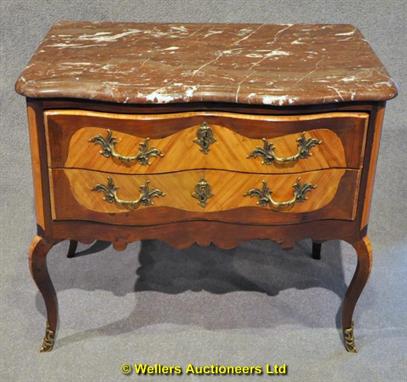FINE GEORGE III MAHOGANY AND CROSSBANDED SERPENTINE COMMODE ATTRIBUTED TO JOHN COBB, CIRCA 1760 with gilt bronze mounts, the shaped moulded top above a brushing slide and three long graduated drawers, raised on splayed bracket feet with sabots 126cm wide, 60cm deep, 88cm high Provenance: Kinnaird Estate, Dunkeld, Perthshire. Note: John Cobb (1715-1778) worked in premises at 72 St Martin`s Lane, London. He completed his apprenticeship in 1736 and went into partnership with William Vile in 1751. Upon Vile`s retirement in 1764 Cobb took over the firm. At this time Cobb took a managerial role and was primarily concerned with design and quality control. A change in direction was required to meet competition from other London firms such as Thomas Chippendale and John Linnell The neo-classical taste gradually took hold from the mid 1760s, first in an increasingly refined vocabulary of marquetry decoration applied to the bombé and serpentine forms of the `French manner` of the 1750s introduced to London by Pierre Langlois and popularised by Chippendale`s Director.
We found 19970 price guide item(s) matching your search
There are 19970 lots that match your search criteria. Subscribe now to get instant access to the full price guide service.
Click here to subscribe- List
- Grid
-
19970 item(s)/page
FINE GEORGE III MAHOGANY AND CROSSBANDED SERPENTINE COMMODE ATTRIBUTED TO JOHN COBB, CIRCA 1770 with gilt bronze mounts, the shaped top above two long drawers, raised on square cabriole legs ending in sabots 93cm wide, 78cm high, 52cm deep Provenance: Kinnaird Estate, Dunkeld, Perthshire. Note: bears a Frank Partridge ivorine trade label.
An 18th Century Dutch Walnut & Marquetry Commode Chest. The serpentine top having a moulded edge and inlaid with an extravagant display of meandering floral stems cascading form an urn and bordered in chequer banding. The bombé front fitted with four long cock-beaded drawers inlaid with floriate sprays and chequer banding and fitted with brass swing handles onwinged back-plates & conforming escutcheons embellished with punchwork. The canted serpentine corners leading down to shaped block feet, 32½ins (83 cms) high.* ]
AN ITALIAN ROSEWOOD MARQUETRY TULIPWOOD COMMODE OF NEO-CLASSICAL STYLE, FIRST HALF 20TH CENTURY Line inlaid and crossbanded throughout, decorated to the top and sides with stylised foliate medallions, on tapering legs 31½ in. (80 cm.) high; 20¾ in. (53 cm.) wide; 15 in. (38 cm.) deep View on Christie's.com
AN ITALIAN PARCEL-GILT AND PAINTED SERPENTINE COMMODE SECOND HALF 18TH CENTURY AND LATER DECORATED The faux marble top above three drawers and two long drawers on scroll feet, later decorated throughout 32¼ in. (82 cm.) high; 48¼ in. (122.5 cm.) wide; 24½ in. (62.5 cm.) deep View on Christie's.com
A BIEDERMEIER MAHOGANY, EBONISED AND PARCEL GILT SECRETAIRE COMMODE EARLY 19TH CENTURY The plain rectangular top above a fall front secretaire-drawer with fitted interior over three further graduated long drawers on lion's-paw carved feet, restorations 36½ in. (93 cm.) high; 40½ in. (103 cm.) wide; 18 in. (46 cm.) deep View on Christie's.com
A satinwood and mahogany crossbanded painted demi lune commode, 20th Century, the shaped carerra marble top above a painted frieze, the central door painted with female figure, the side panels with floral decoration, all raised on curved swept feet, 33 x 33 1/2 x 16 1/2in. (83.5 x 85 x 42cms).
-
19970 item(s)/page











































